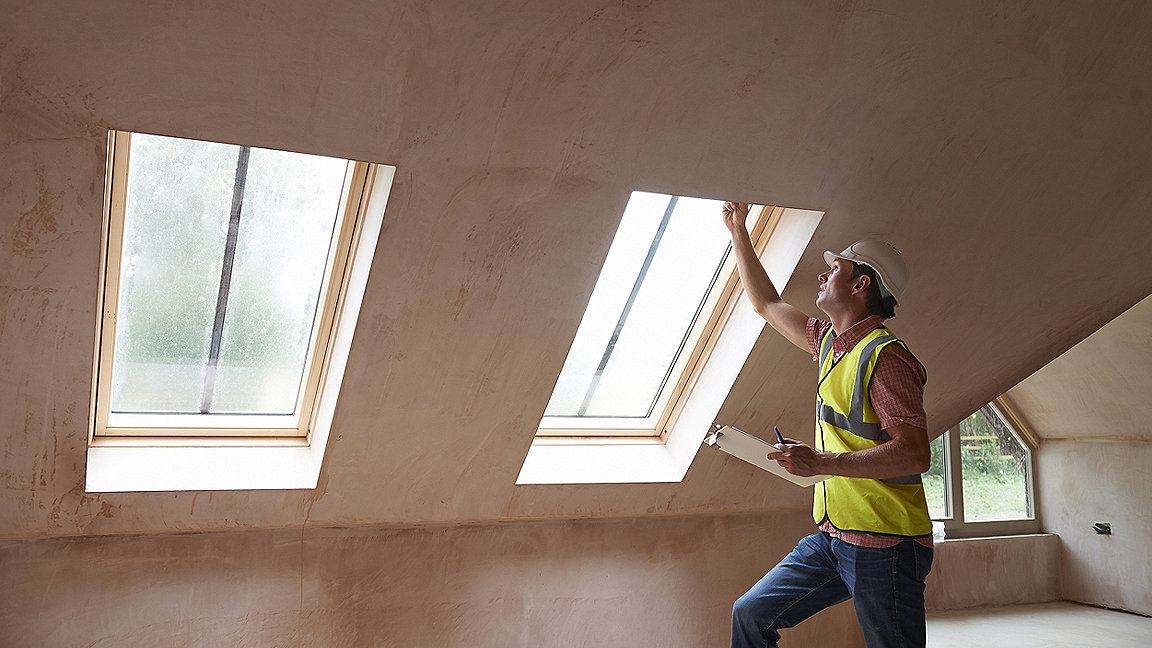
Health and safety is a level 2 mandatory competency for all APC candidates. It requires an understanding of 'the relationship between the work of the surveyor and health and safety issues.
'Candidates should understand the legal, practical and regulatory requirements. They should have a detailed understanding of the health and safety processes and guidelines used to achieve this'.
Asbestos: use of asbestos was comprehensively banned in the UK in 1999, although it is still found in the construction of many buildings. When disturbed and breathed in, it can lead to an often fatal disease known as asbestosis. Surveyors need to be aware of asbestos-containing materials, such as decorative plaster and pipe insulation, as well as familiarising themselves with the current edition of RICS' Asbestos professional standard and the Control of Asbestos Regulations 2012.
Breach: a breach of the Health and Safety at Work etc. Act 1974 can lead to an unlimited fine, up to two years in prison, or both. It is, therefore, very important for employers to adhere to this legislation by providing safe systems of work, safe equipment and training for employees.
Construction (Design and Management) (CDM) Regulations 2015: these place various responsibilities for health and safety on key duty holders, including the client, principal designer and principal contractor.
Devices: devices are often provided to staff who are working alone on site enabling them to stay safe. This is particularly important given the case of Suzy Lamplugh, an estate agent who went missing in London after meeting a client in 1986. Lone working should always be avoided if possible; if not, a lone working device can be an excellent way to track staff and allow them to seek help in the event of an emergency.
Electricity: the Electrical Safety Standards in the Private Rented Sector (England) Regulations 2020 require electrical installation condition reports to be undertaken every five years for residential lettings on assured shorthold tenancies or houses in multiple occupation. Such a report must be provided by a competent person, such as an electrician registered with the National Inspection Council for Electrical Installation Contracting (NICEIC). The report must be given to the tenant before the start of their tenancy or within 28 days of being undertaken.
F10 form: the Health and Safety Executive (HSE) must be notified about some projects under the CDM, using an F10 form. This is necessary where work will last longer than 30 days and has more than 20 workers on site working at one time, or where it will exceed 500 person days of work. Even if a project is not notifiable, however, the CDM still apply in full.
Gas: the Gas Safety (Installation and Use) Regulations 1998 require residential landlords to keep all gas apparatus and pipework in a safe condition, with an annual check undertaken by an engineer on the Gas Safe Register. The landlord must give the tenant a copy of the gas safety check certificate before moving in or within 28 days of the check being carried out.
Health and Safety at Work etc. Act 1974: this is the key UK legislation in this area, requiring employers to be responsible for the health and safety of their employees by training staff and providing safe equipment and working environments. It also requires employees to take responsibility for their own health and safety and that of others under their duty of care; for example, colleagues on site visits.
Injuries: under the Reporting of Injuries, Diseases and Dangerous Occurrences Regulations 1995 (RIDDOR), employers must report and record work-related accidents that cause serious injuries or deaths, as well as specified industrial diseases, such as occupational asthma, and dangerous occurrences, such as plant or equipment coming into contact with overhead power lines.
Jurisdiction: candidates need to be aware of the health and safety legislation applying to the jurisdiction that they work in. For example, in the UK this is the 1974 Act, while in Ireland it is the Safety, Health and Welfare at Work Act 2005 (as amended).
(Approved Document) K: Part K of the Building Regulations relates to protection from falling, collision and impact. This includes requirements for glazing, stairs, ladders, ramps, balustrades and handrails.
Legionnaires' disease: legionella bacteria can be released into the air by water systems such as air conditioning or hot tubs, causing a form of fatal pneumonia known as legionnaires' disease. Regular maintenance of equipment and keeping water temperatures between 20°C and 45°C can help to reduce the risk.
'Employers must report and record work-related accidents that cause serious injuries or deaths, as well as specified industrial diseases'
Manslaughter: corporate manslaughter, or corporate homicide in Scotland, is an offence under the Corporate Manslaughter and Corporate Homicide Act 2007. This offence occurs when a company breaches its duty of care, such as a management failure, and this leads to the death of a contractor or an employee. Penalties under the act include an unlimited fine, prison sentence and disqualification as a company director.
New environments: when a surveyor enters or inspects a new environment, they must assess the risks dynamically. This means being aware of their surroundings and anticipating that unforeseen hazards may arise, such as a dog in a residential property or asbestos in an industrial building. The surveyor will then need to adapt their inspection routine or actions accordingly, to minimise the risk of harm. In the worst case, this could mean withdrawing from the inspection, recording this limitation in their report and visiting the site again when it has been made safe.
Occupiers' liability: those in control of premises have a duty of care towards visitors under the Occupiers' Liability Act 1957, and to trespassers under the Occupiers Liability Act 1984. A higher duty of care is owed to visitors than trespassers, as the latter do not usually have consent to be on the premises and their presence is unknown to occupiers. The law still provides trespassers with some form of protection, however, as a common duty to all.
(Approved Document) P: Part P of the Building Regulations requires that, apart from exempt minor work, any works to fixed electrical installations must either be carried out by an electrician registered with a government-approved competent person scheme such as NICEIC or ELECSA, or be reported to the local authority's building control team. Work must be undertaken to the requirements of BS 7671: 2018 + A2: 2022 and a safety certificate issued on completion.
Quick or slow? Health and safety is not something that can be rushed. Firms should take the time to carry out risk assessments and train their employees to a suitable level of competence, while employees need to understand how to work safely and use personal protective equipment appropriately.
Regulation 4: the fourth of the Control of Asbestos Regulations 2012 requires the duty holder – that is the owner of the premises or the tenant with a full repairing lease – to manage asbestos if it is or is presumed to be present.
Safe word: having a safe word or phrase agreed with your office is advised in the event of emergency. This could be as simple as asking the office to 'Call Mrs Jones'. This can alert your colleagues and/or employer to potential danger or a health and safety issue without drawing attention to yourself or your situation.
Toxic substances: under the Control of Substances Hazardous to Health (COSHH) Regulations 2002, employers need to control exposure to substances or materials that cause harm to health. Examples include dust, gases, fumes, liquids, gels and powders from sources such as paint, cleaners, solder fumes, blood and waste. Risk assessment is required to identify the health hazards, prevent harm, take control measures and provide training, monitoring and emergency planning.
Unpleasant odours: if a local authority receives a complaint about a business or industrial premises, odours can be classed as a statutory nuisance under the Environmental Protection Act 1990. The smell must unreasonably and substantially interfere with the use of another premises, whether residential or commercial, or injure or be likely to injure the health of a person. An abatement notice can be served to try to restrict the odour being emitted. Examples of such nuisances include spreading agricultural slurry, poor extraction from commercial kitchens, smells from abattoirs, and solvents from workshops.
Vehicles: surveyors are often on the road driving between home, office and sites. This presents myriad risks, including vehicle safety, driving proficiency, planning and managing journeys, safety when parking, travel times, posture issues and stress. Driving to a site late in the day in the winter could for instance present risks of bad weather, ice and darkness. Such risks need to be controlled by both employers and surveyors, managing site visits and ensuring that vehicles and employees are equipped for poor conditions. If in doubt, though, surveyors should not travel and postpone inspections.
'Employers and surveyors must manage site visits and ensure that vehicles and employees are equipped for poor conditions'
Workplace stress: stress in the workplace has multiple causes, including unreasonable demands, lack of control, insufficient support, difficult relationships, unclear job roles and changes in the working environment. Such stress can have a severe impact on employees' mental and physical health, and needs to be identified and dealt with as soon as possible. It can lead to absence, errors, and resignations, as well as long-term impacts on the person themselves.
X-ray scanning: this can be used as a non-destructive and non-contact method of identifying pipework and electrical installations inside buildings or under the ground. This means that plans can be drawn up and work undertaken safely, mitigating the risk of harm to staff or contractors.
Yearly checks: employers should review their health and safety risk assessments at least once a year, or more regularly if risks change substantially. This ensures that any changes are reflected in the assessment, and that appropriate control measures are introduced. Various legislation, such as the Gas Safety (Installation and Use) Regulations 1998 and the Electrical Safety Standards in the Private Rented Sector (England) Regulations 2020, require annual checks.
Zone: in bathrooms, electrical safety is managed through the use of various electrical zones. These are set out in the current edition of the Institution of Engineering and Technology's Wiring Regulations. Zone 0 is inside a bath, basin or shower; that is, any area that can hold water. Zone 1 is the splash zone, where the electrical installation could get wet but would not be underwater. Zone 2 extends to 600mm above or to the sides of a bath or shower, which could be splashed but is unlikely to get soaked. There are different requirements for what can be installed in each zone in terms of the maximum voltage and the ingress protection rating (under BS EN 60529:1992).
Jen Lemen FRICS is co-founder of Property Elite
Contact Jen: Email
Related competencies include: Health and safety
Surveying safely: health and safety principles for property professionals
Appropriate management of health and safety is a requirement for all RICS-regulated firms and RICS members, including property-related businesses. The requirement for such management has been put in place in many countries across the globe and across industry sectors and governmental organisations in order to protect individuals from harm.
This guidance note sets out basic, good practice principles for the management of health and safety for RICS-regulated firms and RICS members.
It sets out principles for those engaged in the built environment as property professionals and includes health and safety responsibilities at a corporate level (whether the RICS-regulated firm is large or small) and at the level of the individual RICS member.
It covers property-related businesses and identifies the moral, ethical and practical issues that confront RICS-regulated firms and RICS members everywhere, in all the work that they undertake.

